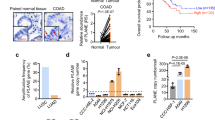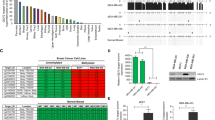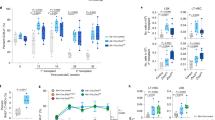Abstract
ZAC encodes a zinc finger protein with antiproliferative activity, is maternally imprinted and is a candidate for the tumor suppressor gene on 6q24. ZAC expression is frequently lost in breast and ovary tumor-derived cell lines and down-regulated in breast primary tumors. In this report, we describe ZACΔ2, an alternatively spliced variant of ZAC lacking the sequence encoding the two N-terminal zinc fingers. Messenger RNAs encoding ZAC or ZACΔ2 were equally abundant and both proteins were nuclear. ZACΔ2 displayed an improved transactivation activity and an enhanced affinity for a ZAC binding site, suggesting that the two N-terminal zinc fingers negatively regulated ZAC binding to its target DNA sequences. Both proteins were equally efficient in preventing colony formation, indicating similar overall antiproliferative activities. However, these activities resulted from a differential regulation of apoptosis vs cell cycle progression since ZACΔ2 was more efficient at induction of cell cycle arrest than ZAC, whereas it was the reverse for apoptosis induction. Hence, these data further underline that ZAC gene is critically controlled, both at the transcriptional level through imprinting and at the functional level through alternative splicing.
This is a preview of subscription content, access via your institution
Access options
Subscribe to this journal
Receive 50 print issues and online access
$259.00 per year
only $5.18 per issue
Buy this article
- Purchase on Springer Link
- Instant access to full article PDF
Prices may be subject to local taxes which are calculated during checkout






Similar content being viewed by others
References
Abdollahi A, Bao R and Hamilton TC. . 1999 Oncogene 18: 6477–6487.
Abdollahi A, Godwin AK, Miller PD, Getts LA, Schultz DC, Taguchi T, Testa JR and Hamilton TC. . 1997a Cancer Res. 57: 2029–2034.
Abdollahi A, Roberts D, Godwin AK, Schultz DC, Sonoda G, Testa JR and Hamilton TC. . 1997b Oncogene 14: 1973–1979.
Bickmore WA, Oghene K, Little MH, Seawright A, van Heyningen V and Hastie ND. . 1992 Science 257: 235–237.
Bilanges B, Varrault A, Basyuk E, Rodriguez C, Mazumdar A, Pantaloni C, Bockaert J, Theillet C, Spengler D and Journot L. . 1999 Oncogene 18: 3979–3988.
Cabanillas AM and Darling DS. . 1996 DNA Cell. Biol. 15: 643–651.
Cavé H, Polak M, Drunat S, Denamur E and Czernichow P. . 2000 Diabetes 49: 108–113.
Chappell SA, Walsh T, Walker RA and Shaw JA. . 1997 Br. J. Cancer 75: 1324–1329.
Chen X, Agarwal A and Giedroc DP. . 1998 Biochemistry 37: 11152–11161.
Chen X, Chu M and Giedroc DP. . 1999 Biochemistry 38: 12915–12925.
Chomczynski P and Sacchi N. . 1987 Anal. Biochem. 162: 156–159.
Devilee P, van Vliet M, van Sloun P, Dijkshoorn NK, Hermans J, Pearson PL and Cornelisse CJ. . 1991 Oncogene 6: 1705–1711.
Ferguson AW and Milner RDG. . 1970 Arch. Dis. Child. 45: 80–81.
Fuji H, Zhou W and Gabrielson E. . 1996 Genes Chrom. Cancer 16: 35–39.
Gardner RJ, Mackay DJG, Mungall AJ, Polychronakos C, Siebert R, Shield JPH, Temple IK and Robinson DO. . 2000 Hum. Mol. Genet. 9: 589–596.
Gogos JA, Hsu T, Bolton J and Kafatos FC. . 1992 Science 257: 1951–1955.
Hanas JS, Hazuda DJ, Bogenhagen DF, Wu FY-H and Wu C-W. . 1983 J. Biol. Chem. 258: 14120–14125.
Hsu T, Gogos JA, Kirsh SA and Kafotos FC. . 1992 Science 257: 1946–1950.
Huang SM and Stallcup MR. . 2000 Mol. Cell. Biol. 20: 1855–1867.
Kamiya M, Judson H, Okazaki Y, Kusakabe M, Muramatsu M, Takada S, Takagi N, Arima T, Wake N, Kamimura K, Satomura K, Hermann R, Bonthron DT and Hayashizaki Y. . 2000 Hum. Mol. Genet. 9: 453–460.
Kas K, Voz ML, Roijer E, Astrom AK, Meyen E, Stenman G and Van de Ven WJ. . 1997 Nature Genet. 15: 170–174.
Klug A and Schwabe JWR. . 1995 FASEB J. 9: 597–604.
Knudson AG. . 1971 Proc. Natl. Acad. Sci. USA 68: 820–823.
Knudson AG. . 1993 Proc. Natl. Acad. Sci. USA 90: 10914–10921.
Lassus P and Hibner U. . 1998 Nucleic Acid Res. 26: 5233–5234.
Mackay JP and Crossley M. . 1998 Trends Biol. Sci. 23: 1–4.
Miller J, McLachlan AD and Klug A. . 1985 EMBO J. 4: 1609–1614.
Negrini M, Sabbioni S, Possati L, Rattan S, Corallini A, Barbanti-Brodano G and Croce CM. . 1994 Cancer Res. 54: 1331–1336.
Nishizaki T, DeVries S, Chew K, Goodson III WH, Ljung B-M, Thor A and Waldman FM. . 1997 Genes Chrom. Cancer 19: 267–272.
Noviello C, Courjal F and Theillet C. . 1996 Clin. Cancer Res. 2: 1601–1606.
Orphanos V, McGown G, Hey J, Boyle JM and Santobanez-Koref M. . 1995 Br. J. Cancer 71: 290–293.
Queimado L, Lopes C, Du F, Martins C, Bowcock AM, Soares J and Lovett M. . 1999 Lab. Invest. 79: 583–589.
Read D and Manley JL. . 1992 EMBO J. 11: 1035–1044.
Scharnhorst V, Kranenburg O, van der Eb AJ and Jochemsen AG. . 1997 Cell Growth Differ. 8: 133–143.
Sheng ZM, Marchetti A, Buttitta F, Champene M-H, Campani D, Bistocchi M, Lidereau R and Callahan R. . 1996 Br. J. Cancer 73: 144–147.
Spengler D, Villalba M, Hoffmann A, Pantaloni C, Houssami S, Bockaert J and Journot L. . 1997 EMBO J. 16: 2814–2825.
Theile M, Seitz S, Arnold W, Jandrig B, Frege R, Schlag PM, Haensch W, Guski H, Winzer K-J, Barrett JC and Scherneck S. . 1996 Oncogene 13: 677–685.
Trainor CD, Ghirlando R and Simpson MA. . 2000 J. Biol. Chem. 275: 28157–28166.
Varrault A, Ciani E, Apiou F, Bilanges B, Hoffmann A, Pantaloni C, Bockaert J, Spengler D and Journot L. . 1998 Proc. Natl. Acad. Sci. USA 95: 8835–8840.
Acknowledgements
This work was supported by grants from the Centre Nationale de la Recherche Scientifique, La Ligue Nationale contre le Cancer, L'Association pour la Recherche contre le Cancer (ARC), the European Commission (QLG3-CT-1999-00602) to L Journot and from the Deutsche Forschungsgemeinschaft (Sp 386/3-1) to D Spengler. B Bilanges is a recipient of predoctoral fellowships from the Ministère de l'Education Nationale, de la Recherche et de la Technologie and from the ARC. A Mazumdar is a recipient of postdoctoral fellowships from the Fondation pour la Recherche Médicale and the ARC.
Author information
Authors and Affiliations
Rights and permissions
About this article
Cite this article
Bilanges, B., Varrault, A., Mazumdar, A. et al. Alternative splicing of the imprinted candidate tumor suppressor gene ZAC regulates its antiproliferative and DNA binding activities. Oncogene 20, 1246–1253 (2001). https://doi.org/10.1038/sj.onc.1204237
Received:
Revised:
Accepted:
Published:
Issue Date:
DOI: https://doi.org/10.1038/sj.onc.1204237
Keywords
This article is cited by
-
Specific changes in the expression of imprinted genes in prostate cancer—implications for cancer progression and epigenetic regulation
Asian Journal of Andrology (2012)
-
Zac1 plays a key role in the development of specific neuronal subsets in the mouse cerebellum
Neural Development (2011)
-
Resolution of infection promotes a state of dormancy and long survival of CD4 memory T cells
Immunology & Cell Biology (2011)
-
Differential expression pattern of ZAC in developing mouse and human pancreas
Journal of Molecular Histology (2011)
-
Bisulphite sequencing of the transient neonatal diabetes mellitus DMR facilitates a novel diagnostic test but reveals no methylation anomalies in patients of unknown aetiology
Human Genetics (2005)



